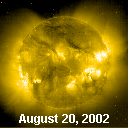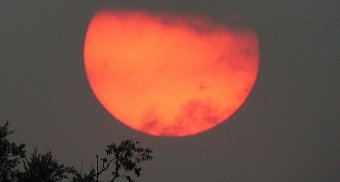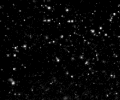|   SPACE WEATHER SPACE WEATHER
Current
Conditions
Solar Wind
speed: 460.5 km/s
density:1.3 protons/cm3
explanation | more data
Updated: Today at 2246 UT
X-ray Solar Flares
6-hr max: M1 2115 UT Aug20
24-hr: M3 0140 UT Aug20
explanation | more data
Updated: Today at 2245 UT
Daily Sun: 20 Aug '02 
Sunspot 69 has a delta-class magnetic field that harbors energy for X-class solar flares. Image credit: SOHO/MDI
The Far Side of the Sun

This holographic image reveals some sunspots on the far side of the Sun. Image credit: SOHO/MDI
Sunspot Number: 247
More about sunspots
Updated: 19 Aug 2002
Coronal Holes:

There are no substantial coronal holes on the Earth-facing side of the Sun. Image credit: SOHO Extreme UV Telescope.
More about coronal holes Interplanetary Mag. Field
Btotal: 9.1 nT
Bz: 6.9 nT south
explanation | more data
Updated: Today at 2247 UT
 SPACE WEATHER SPACE WEATHER
NOAA
Forecasts
Solar Flares: Probabilities for a medium-sized (M-class) or a major (X-class) solar flare during the next 24/48 hours are tabulated below.
Updated at 2002 Aug 20 2200 UTC
| FLARE | 0-24 hr | 24-48 hr | | CLASS M | 75 % | 75 % | | CLASS X | 20 % | 20 % |
Geomagnetic Storms: Probabilities for significant disturbances in Earth's magnetic field are given for three activity levels: active, minor storm, severe storm
Updated at 2002 Aug 20 2200 UTC Mid-latitudes | 0-24 hr | 24-48 hr | | ACTIVE | 30 % | 30 % | | MINOR | 15 % | 15 % | | SEVERE | 05 % | 05 % |
High latitudes | 0-24 hr | 24-48 hr | | ACTIVE | 35 % | 35 % | | MINOR | 20 % | 20 % | | SEVERE | 10 % | 10 % |

Web server provided by
VPS Hosting | What's Up in Space -- 20 Aug 2002
Subscribe to Space Weather News! BIG SUNSPOT: Giant sunspot 69 is impressive. It stretches nine Earth diameters from end to end and poses a threat for powerful X-class solar flares. You can see the spot yourself--but never look directly at the Sun. Use safe solar projection techniques instead.  Above: Can you find sunspot 69 in this cloudy picture of the setting Sun? Click here for a hint. Image credit: Gunther Groenez. MAGNETIC IMPACT: A coronal mass ejection struck Earth's magnetic field on August 18th at 1848 UT (2:48 p.m. EDT) and triggered a G1-class geomagnetic storm, which has since subsided. Sky watchers in northern Europe and Canada saw Northern Lights.  NEARBY ASTEROID: Asteroid 2002 NY40 came so close to Earth on August 18th that people could see it through binoculars or small telescopes. "It moved very quickly against the background field of stars. Very impressive, and a hard object to find and keep in the field of view," says Canadian amateur astronomer Lance Taylor, who used a 7-inch telescope to view the asteroid. "Visually it looked almost like a satellite--just farther away." [gallery] NEARBY ASTEROID: Asteroid 2002 NY40 came so close to Earth on August 18th that people could see it through binoculars or small telescopes. "It moved very quickly against the background field of stars. Very impressive, and a hard object to find and keep in the field of view," says Canadian amateur astronomer Lance Taylor, who used a 7-inch telescope to view the asteroid. "Visually it looked almost like a satellite--just farther away." [gallery]
METEOR SHOWER: The annual Perseid meteor shower peaked on August 12th and 13th. This year's shower was perhaps less impressive than usual. Nevertheless, sky watchers spotted plenty of bright shooting stars--including some colorful earthgrazers. Visit our photo gallery and see for yourself. WEB LINKS: NOAA FORECAST | GLOSSARY | SPACE WEATHER TUTORIAL | LESSON PLANS | BECOME A SUBSCRIBER | 
Potentially Hazardous Asteroids (PHAs) are space rocks larger than approximately 100m that can come closer to Earth than 0.05 AU. None of the known PHAs are on a collision course with our planet, although astronomers are finding new ones all the time.
On 20 Aug 2002 there were 453 known Potentially
Hazardous Asteroids August 2002 Earth-asteroid encountersNotes: LD is a "Lunar Distance." 1 LD = 384,401 km, the distance between Earth and the Moon. 1 LD also equals 0.00256 AU. MAG is the visual magnitude of the asteroid on the date of closest approach.  - AURORA SURPRISE: An unexpected geomagnetic storm began on August 1st as night fell across North America. Sky watchers spotted vivid auroras over both the United States and Canada.
- CRESCENT SUN: The June 10th solar eclipse is long over, but new pictures of the event keep appearing. Visit our growing photo gallery and see for yourself. There are strange shadows, weird sunsets, eclipse dogs, crescent-eyed turkeys and extraordinary rings of fire. [more]
- COMET IKEYA-ZHANG: The brightest comet in years delighted sky watchers in March and April 2002. [gallery]
- GONE JUPITER: On Feb. 22, 2002, the Moon had a close encounter with Jupiter. [gallery]
- GONE SATURN: On Feb. 20, 2002, the Moon glided in front of Saturn and its mysterious rings. [gallery]
- HOT COMET: Periodic comet 96P/Machholz put on a dazzling show as it swung by the Sun on Jan. 8, 2002.
- ASTEROID FLYBY: Asteroid 2001 YB5 raced past Earth on Jan. 7, 2002, only two times farther away than the Moon. [gallery]
- SUBTLE ECLIPSE: The Moon dipped into the outskirts of Earth's shadow on Dec. 30, 2001. [gallery]
- MOON & SATURN: The Moon keeps getting in the way of Saturn! See the series of close encounters here.
- CHRISTMAS LIGHTS: On Christmas Eve, 2001, a solar wind stream triggered Northern Lights. [gallery]
- SOLAR ECLIPSE: Sky watchers in Hawaii and most parts of North America experienced a partial solar eclipse on Dec. 14th. [gallery]
- BRIGHT ASTEROID: Videos and images of 1998 WT24 -- a big and bright near-Earth asteroid that came close to our planet on Dec. 16, 2001. [gallery]
- NORTHERN LIGHTS: On Nov. 24th a pair of coronal mass ejections swept past Earth and triggered worldwide auroras.
- LEONIDS 2001: Some people saw it. Others heard it. In either case, they'll never forget it: The 2001 Leonid meteor storm.
- PERSEIDS 2001: Perseid watchers on August 12th spotted meteors, auroras, and a disintegrating Russian rocket! [gallery]
- MORNING PLANETS: In July and Aug. 2001, the Moon, Jupiter, Saturn, Venus, and Mercury put on a dazzling early-morning sky show. [gallery]
- ECLIPSE SAFARI: Onlookers cried out in delight on June 21, 2001, when the Moon covered the African Sun, revealing the dazzling corona. [gallery]
- TOTAL LUNAR ECLIPSE: On Jan. 9, 2001, the full Moon glided through Earth's copper-colored shadow. [gallery]
- CHRISTMAS ECLIPSE: Sky watchers across North America enjoyed a partial solar eclipse on Christmas Day 2000 [gallery]
- LEONIDS 2000: Observers around the globe enjoyed three predicted episodes of shooting stars. [gallery]
|

